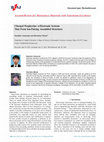Papers by Hiromitsu Maeda
Chemical Communications, 2018
The introduction of aryl groups on a dipyrrolylquinoxaline (dpq) framework enabled the formation ... more The introduction of aryl groups on a dipyrrolylquinoxaline (dpq) framework enabled the formation of extended π-electronic systems that can be included in assembled structures. α-Aryl-substituted dpqs (Ar-dpqs) were converted to...
Chemical Science, 2021
π-Electronic ion pairs comprising porphyrin-based π-electronic anions have exhibited characterist... more π-Electronic ion pairs comprising porphyrin-based π-electronic anions have exhibited characteristic assembling modes and resulting electronic properties such as solid-state absorption and photoinduced electron transfer.
Chemical Science
Hydrostatic pressure can control interactions of chiral countercations with helical receptors con... more Hydrostatic pressure can control interactions of chiral countercations with helical receptors containing anions, causing remarkable chiroptical changes.

Bulletin of the Chemical Society of Japan
Kazuhisa Yamasumi Kazuhisa Yamasumi received his Ph.D. degree in 2020 from Kyushu University unde... more Kazuhisa Yamasumi Kazuhisa Yamasumi received his Ph.D. degree in 2020 from Kyushu University under the guidance of Prof. Hiroyuki Furuta, focusing on isomeric porphyrin analogs. His Ph.D. research was focused on the synthesis of infrared dyes based on the expanded or π-extended isomeric porphyrin analogs. He joined the group of Prof. Hiromitsu Maeda at Ritsumeikan University as a postdoctoral fellow in 2020. His current research focuses on charged porphyrins and ion-pairing assemblies. Hiromitsu Maeda Hiromitsu Maeda received his Ph.D. degree in 2004 from Kyoto University, under the guidance of Prof. Hiroyuki Furuta (Kyushu University) and Prof. Atsuhiro Osuka, after spending three months in the Sessler group, the University of Texas at Austin. In 2004, he started his academic career in the Department of Bioscience and Biotechnology, Faculty of Science and Engineering, Ritsumeikan University. In 2008, he was transferred to the College of Pharmaceutical Sciences, wherein he was promoted to a professor. In 2016, he moved to the Department of Applied Chemistry, College of Life Sciences. He has been awarded several prizes, including ChemComm Emerging Investigator Lectureship (2012) and Fellow of the RSC (2015).
Molecular Systems Design & Engineering
The prologue and progress of π-electronic ion-pairing assemblies, including synthesis of π-electr... more The prologue and progress of π-electronic ion-pairing assemblies, including synthesis of π-electronic ions, preparation of ion pairs, fabrication of assemblies as crystals, gels and liquid crystals and their characteristic properties, are summarized.
European Journal of Organic Chemistry
Organic & Biomolecular Chemistry
Anion-responsive π-electronic molecules with electron-donating aryl substituents exhibited photo-... more Anion-responsive π-electronic molecules with electron-donating aryl substituents exhibited photo-induced electron transfer and resulting fluorescence switching properties, which were controlled by solvent polarity, anion binding and protonation.
Chemistry – A European Journal
Chemistry – An Asian Journal
Chemistry – A European Journal
Chemistry - A European Journal
Chemistry – A European Journal
Chemistry – An Asian Journal
iScience
Porphyrin-Au III complexes were found to act as p-electronic cations, which can combine with vari... more Porphyrin-Au III complexes were found to act as p-electronic cations, which can combine with various counteranions, including p-electronic anions. Single-crystal X-ray analyses revealed the formation of assemblies with contributions of charge-by-charge and charge-segregated assemblies, depending on the geometry and electronic state of the counteranions. Porphyrin-Au III complexes possessing aliphatic alkyl chains formed dimension-controlled ion-pairing assemblies as thermotropic liquid crystals, whose ionic components were highly organized by p-p stacking and electrostatic interactions.
Chemistry – An Asian Journal
Chemistry – A European Journal
Chemistry - A European Journal
Bulletin of the Chemical Society of Japan
Yohei Haketa Yohei Haketa was born in 1984 in Ueda (Nagano), Japan. He received his Ph.D. degree ... more Yohei Haketa Yohei Haketa was born in 1984 in Ueda (Nagano), Japan. He received his Ph.D. degree in 2011 from Ritsumeikan University, under the guidance of Prof. Hiromitsu Maeda, focusing on the assemblies of πconjugated anion receptors. He was selected as a Research Fellow of the Japan Society for the Promotion of Science (JSPS) in 2009-2012. After working in Asahi Kasei Corporation as a researcher (2012-2015), he joined the group of Prof. Hiromitsu Maeda at Ritsumeikan University as a postdoctoral fellow in 2015 and started an academic career as an assistant professor in 2017.

Uploads
Papers by Hiromitsu Maeda